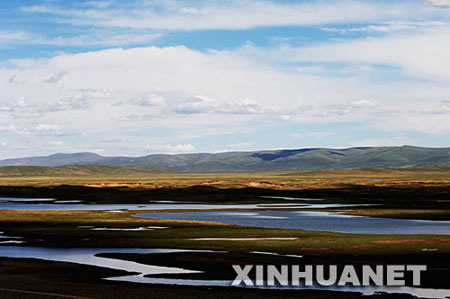Qinghai Province, which shares the roof of the world with Tibet, had a special gift for China on the occasion of the World Environment Day On Friday - a fresh approach toward ecological conservation in the region.
The Qinghai Academy of Social Sciences released a book titled The Studies on the Ecological Values of China's Sanjiangyuan and its Compensation Mechanism to mark the occasion.
In his preface to the book, Qiang Wei, the Party chief of Qinghai, says maintaining a basin of clear water at Sanjiangyuan, the source of Yangtze, Yellow and Lancang rivers is a compelling obligation.

Known as China's water tower, the Sanjiangyuan area lies in southern Qinghai Province, the hinterland of the Qinghai-Tibetan Plateau. It is the source of Yangtze, Yellow and Lancang rivers. (Xinhua Photo)
In a bid to maintain the ecological equilibrium in this pure land, the northwestern province would rather give up its growth rate and gross domestic product (GDP), Qiang writes in the preface, which was published on People's Daily on May 18.
If my memory serves me right, this is the first time a senior Chinese official has come forth and put ecological conservation above economic growth.
Covering an area of 300,250 sq. km., the Sanjiangyuan region, 4,000 m above sea level, holds a vital position in determining the regional climate while circulating water to the three major rivers.
The unique ecosystem here has not only directly affected the formation and evolution of China's climate and hydrology but also made a great impact on the air circulation in East Asia and even in the Northern Hemisphere, says Qiang.
Global climate change was the theme of this year's World Environment Day. And the pro-conservation stance of Qiang and his colleagues is certainly an encouraging sign for the sustainability of the planet.
Qinghai is not the only province in China that has decided to base its progress on ecology. More than a dozen provinces have adopted a similar strategy. But Qinghai is one of the earnest to conserve and recover its ecosystem, even at the expense of its own development.
To guarantee the replenishment of water flowing down the three rivers, which currently nurture more than 1 billion people in China and Southeast Asia, the provincial government has displaced over 10,000 households to preserve the grasslands.
Gold mining, once a revenue pillar for several prefectures in the province, has also been banned to save the vulnerable vegetation, while other underground mineral resources, however abundant in reserve, are prohibited from being tapped.
No industrial projects will be introduced into the Sanjiangyuan region. And GDP growth is no longer a reference to evaluate the officials' accomplishments in the area.
We're looking at a drastic change in the traditional nomadic lifestyle of local people, and a farewell to the mentality that assumes GDP growth is everything.

File photo shows the Sanjiangyuan area, which lies in southern Qinghai Province, the hinterland of the Qinghai-Tibetan Plateau. It is the source of Yangtze, Yellow and Lancang rivers. (Xinhua Photo)
The people of Sanjiangyuan and Qinghai may hardly enjoy the benefits of ecological conservation, but millions of people living downstream the three rivers will know of the sacrifices the locals, of whom more than 70 percent are Tibetan, have made.
Recent studies on Sanjiangyuan's ecological values and its compensation mechanism suggest that efforts to conserve ecology upstream should be compensated. But it will take time.
As an underdeveloped province, Qinghai ranked 22nd in the nation in terms of per capita GDP, at 12,809 yuan (1,883 U.S. dollars) last year. Qinghai's sacrifices for the ecology should not be taken for granted.
Nevertheless, Qiang Wei and his comrades seem determined in their endeavor to preserve the environment.
As Qiang puts it in the preface, The ecological conservation and construction in Qinghai will concern not only the province's progress but also the whole country's sustainable development as well as the Chinese nation's far reaching welfare. It may even concern the global ecological security.
I have never known Qiang in person, and I have no resources to compensate Qinghai for its sacrifices.
I just wish to applaud the official for his vision.
The author is a guest professor of journalism with the Beijing Foreign Studies University.
